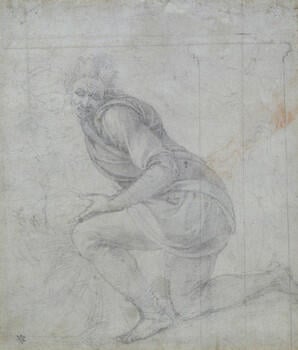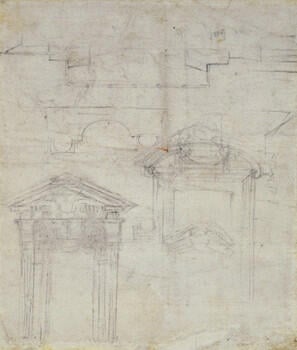-
1 of 253523 objects
Studies for a Lamentation over the Dead Christ c.1540 and c.1560
Black chalk, with some red chalk | 25.8 x 22.2 cm (sheet of paper) | RCIN 912769
-
A double-sided sheet of studies. On the recto, a compositional study of the Lamentation, most of the figures sketched in outline, and a separate study of one man fully worked up. On the verso, a series of architectural studies.
Extending over the whole of the recto is a compositional study of the Lamentation over the Dead Christ, with the figures sketched in outline only. Drawn over the top of that compositional sketch is a separate study for a male figure in a Lamentation, more fully worked up. A later collector cut the sheet down to focus attention on that study, thus truncating the compositional study of the Lamentation. To the right is a light sketch of an outstretched right arm, in red chalk, and the shaft of a column or pilaster, drawn with a ruler.
Johannes Wilde (Popham & Wilde, no. 433) considered the outline sketch to be a first idea for the British Museum’s celebrated drawing known as the Warwick Pietà (BM 1896,0710.1). Though there are significant differences between the two compositions (not least the direction in which Christ is posed), this is supported by the fact that the more complete study of a kneeling man is closely related to the figure at the far right of the Warwick Pietà. The study in red chalk here of an outstretched right arm may be for the figure supporting the head of Christ in the British Museum drawing. Wilde proposed that the drawings were studies for a painting, possibly to be executed by another artist, such as Sebastiano del Piombo. Charles de Tolnay (Corpus 271) suggested that the composition might be preparatory for a marble tondo; though the Warwick Pietà is distinctly circular in form, there is no documentary evidence for this proposal.
Around 1540 Michelangelo drew the Lamentation over the Dead Christ several times, and it is plausible that the drawings are not studies towards some larger project, but independent graphic meditations on the subject. In all of Michelangelo’s drawings of the Lamentation around this date, there is a fusion of forms and emotions into a single anguished mass. The motif of the body of Christ held in the Virgin’s lap is an echo of her cradling her infant son. The emphasis on the bodily contact between the Virgin and the dead Christ relates the drawings to the writings of the circle of Catholic reformers known as the Spirituali, especially the tract composed around the same date by Michelangelo’s friend Vittoria Colonna, Pianto sopra la Passione di Christo (‘Lament on the Passion of Christ’), a meditation on the significance of the Virgin holding the body of her dead son immediately after his Crucifixion, through which divine grace flowed to humanity. This correlation of physical and spiritual communion would have been understood instinctively by Michelangelo, whose art was based on finding material equivalents for spiritual states. These seem therefore to have been meditative exercises, perhaps prompted by (and certainly in sympathy with) the writings of Colonna, intensely personal explorations through the medium of drawing, of the spiritual significance of Christ’s death.
In earlier literature, the attribution of the sheet (and that of the Warwick Pietà) to Michelangelo was questioned: Berenson attributed it to Sebastiano del Piombo, Frey to Michelangelo's pupil Antonio Mini, and Panofsky to Daniele da Volterra. All recent scholarship has accepted Michelangelo's authorship.
Also in the British Museum (T,12.75) is a copy of the present drawing, which shows some of the original lost through trimming, and clarifies the outlines of the composition that are somewhat rubbed here.
On the verso of the sheet is a series of architectural studies, drawn many years after the figure studies on the recto. The two principal studies of portals, with a subsidiary study of a pediment below, are probably connected with Michelangelo’s design of the Porta Pia in Rome, commissioned by Pope Pius IV soon after his election in December 1559. The section or plan just above centre occurs again on a sheet in Casa Buonarroti, of studies for the Roman church of San Giovanni dei Fiorentini, planned by Michelangelo in late 1559. Wilde (Popham and Wilde 1949, no. 433) suggested cautiously that the plan at the top of the sheet, of a portal with a railing of seven balusters, might be for the chapel of Ascanio Sforza in Santa Maria Maggiore, under construction right at the end of Michelangelo’s life. Tolnay (Corpus 271) noted that Michelangelo reused the motif of the herm-pilasters, in the portal at lower left, in the loggia of Palazzo Conservatori in Campidoglio, begun in 1563 and completed by Giacomo della Porta after Michelangelo’s death.
The star mark stamped at lower left of the recto is associated with the seventeenth-century dealer Nicholas Lanier, suggesting that the drawing was acquired during the reign of Charles II (r. 1660-1685).Provenance
Nicholas Lanier (his star mark, Lugt 2885); probably acquired by Charles II; listed in George III's 'Inventory A,' c.1800-20, p. 44, 'Mich: Angelo Buonarroti' / Tom. I. (c. 1802): '24. figure kneeling in an attitude of Surprize'
-
Creator(s)
Previously attributed to (artist)Acquirer(s)
-
Medium and techniques
Black chalk, with some red chalk
Measurements
25.8 x 22.2 cm (sheet of paper)
Markings
watermark: Roberts C: Eagle in circle, medium-sized [Watermark]
Other number(s)
RL 12769Alternative title(s)
Verso: Architectural studies

